The dynamic behaviour of the roof interventions in the Basilica San Francesco in Assisi

|
|
|||||||||||
Bibliographic Details
| Author(s): |
Vincenzo Arcidiacono
Emidio Piermarini Gian Paolo Cimellaro John Oschendorf |
||||
|---|---|---|---|---|---|
| Medium: | conference paper | ||||
| Language(s): | English | ||||
| Conference: | IABSE Conference: Elegance in structures, Nara, Japan, 13-15 May 2015 | ||||
| Published in: | IABSE Conference Nara 2015 | ||||
|
|||||
| Page(s): | 208-209 | ||||
| Total no. of pages: | 8 | ||||
| Year: | 2015 | ||||
| DOI: | 10.2749/222137815815774629 | ||||
| Abstract: |
During the 1997 Umbria-Marche earthquake, two of the vaults of the Basilica of San Francesco in Assisi collapsed as a result of two earthquakes with 5.6 and 5.8 magnitudes. The structure had endured stronger earthquakes for centuries before these events, and there are likely many reasons for the 1997 collapse, such as damages cumulated from previous earthquakes or the retrofitting made to the structure over its lifetime. A full description and history of the different retrofit interventions of the Basilica are presented. In particular, the Basilica's roof has been subjected to three major restorations in its life. Besides, this study considers the effects of the different roof interventions on the global dynamic behavior of the structure. A simple analytical model is employed to show trends in the structure's seismic response to the 2nd shock of the 1997 earthquake given the changes in stiffness and mass of the roof over the centuries. The results of the analytical model suggest that the roof interventions have had the effect of decreasing the structure's fundamental period, and therefore, attracting more seismic loads to the façade and the transept. These were overloaded, leading to a probable nonlinear behavior that might explain the collapse of the two Gothic vaults. |
||||
| Keywords: |
collapse dynamic behavior retrofit churches masonry buildings historical buildings
|
||||
